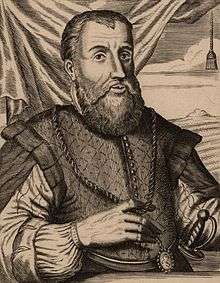Diego Velázquez de Cuéllar
Diego Velázquez de Cuéllar (Spanish: [ˈdjeɣo βeˈlaθkeθ ðe ˈkweʎaɾ]; 1465 – c. June 12, 1524) was a Spanish conquistador. He conquered and governed Cuba on behalf of Spain and moved Havana from the south coast of western Cuba to the north coast, placing it well as a port for Spanish trade.[1]
Diego Velázquez de Cuéllar | |
|---|---|
 | |
| 5th Governor of the Indies | |
| In office 1518–1524 | |
| Preceded by | Diego Columbus |
| Succeeded by | Hernán Cortés (as the Governor of New Spain) |
| 1st Governor of Cuba | |
| In office 1511–1524 | |
| Succeeded by | Manuel de Rojas y Córdova |
| Personal details | |
| Born | 1465 Cuéllar, Segovia, Crown of Castile |
| Died | c. June 12, 1524 (aged 58–59) Santiago de Cuba, Cuba, New Spain |
Early life
Little is known about the early life of Diego Velázquez.[2] He was born in Cuéllar c. 1465, in the Segovia region of Spain. Velázquez was known for his hatred of manual labor from a young age, which played a role in him eventually becoming a conquistador. Diego Velázquez was a part of the Spanish military, serving in Naples, and then returning to Spain to serve in Seville. Velázquez was met with all the excitement from Christopher Columbus's first voyage to the new world, so Velázquez made sure he was on the second voyage of Christopher Columbus.
Velázquez settled on the island of Espanola, where he befriended Bartholomew Columbus, the younger brother of Christopher. Columbus took a liking to Velázquez and when Columbus had to leave the island for any period of time would make Velázquez acting governor of the Indies. Velázquez squashed an Indian revolt in 1503 by sending a captain to a part of the island while he went and captured the king of the revolting Indians which ended the revolt. The Governor of the Indies at this time was Nicolás de Ovando y Cáceres, and after the revolt decided that five new towns should be built. Velázquez helped form three of these towns, the names of the towns were Salvatierra de la Zabana, Yáquimo, and San Juan de la Maguana. According to historian Troy S. Floyd, "Velázquez himself, reportedly wealthy in island terms by 1511, held encomiendas at Verapaz, Salvatierra de la Zabana, and Santiago de Caballeros, where he was in partnership with an unidentified encomendero in mining enterprises."[3]
He married the daughter of Cristóbal de Cuéllar, who died soon afterwards. He never remarried.[3]:139
Conquest of Cuba
He was named to lead the expedition of conquest of Cuba in 1511, with 300 men, a three-year undertaking noted for its brutality.[4] He acted under orders from Diego Columbus, recently restored as Viceroy of the Indies. He founded a number of new Spanish settlements and cities on the island, first Baracoa in 1511 and then most notably Santiago de Cuba in 1514 and Havana in 1515. Velázquez was appointed Governor of Cuba.[5]:16 The new settlers did not wish to be under the personal authority of Diego Columbus, so Velázquez convoked a general cabildo (a local government council) which was duly authorized to deal directly with Spain, and therefore removed Velázquez and the settlers from under the authority of Columbus, their nominal superior. It was a precedent that would come back to haunt him with the Mexican adventures.
Conquest of Mexico
He authorized various expeditions to explore lands further west, including the 1517 Francisco Hernández de Córdoba expedition to Yucatán (see: Spanish Conquest of Yucatán), and Juan de Grijalva's 1518 expedition.[5]:16,27 He was made the first Adelantado of Cuba with jurisdiction over the former Governorship of the Indies.[5]:126 He initially backed Hernán Cortés's expedition to Mexico,[5]:44–47 but pulled back his support before the expedition was scheduled to launch. Cortés disobeyed Velázquez's orders to disband his expeditionary force and left for Mexico anyway.[5]:56
Later life
Velázquez lost his governorship of Cuba in 1521, for his misuse of indigenous labor, but he was restored to office in 1523. At the time of his unexpected death in 1524 at age 59, he was "the richest Spaniard in the Americas," despite financial losses on the expedition of Francisco Hernández de Córdoba and of Hernán Cortés. He completed the successful conquest of Cuba, founded towns that remain important, made Cuba economically prosperous, and turned it into the staging point for expeditions of conquest elsewhere.[6]
See also
- List of Viceroys of New Spain
- Viceroyalty of New Spain
- History of Cuba
- History of Havana
- Juan de Grijalva
References
- Allan J. Kuethe, "Havana" in Encyclopedia of Latin American History and Culture, vol. 3, p. 173. New York: Charles Scribner's Sons 1996.
- Jacquelyn Briggs Kent, "Diego de Velásquez" in Encyclopedia of Latin American History and Culture, vol. 5. p. 375. New York: Charles Scribner's Sons 1996.
- Floyd, Troy (1973). The Columbus Dynasty in the Caribbean, 1492-1526. Albuquerque: University of New Mexico Press. pp. 63, 81.
- Kent, "Diego de Velásquez", p. 375.
- Diaz, B., 1963, The Conquest of New Spain, London: Penguin Books, ISBN 0140441239
- Kent, "Diego de Velásquez" p. 375.
Sources
- Florstedt, R. (1942). Diego Velazquez First Governor of Cuba. 1-28. Retrieved October 18, 2017.
- Wright, Irene. The Early History of Cuba, 1492-1586. (1916, rep. 1970)
External links
| Library resources about Diego Velázquez de Cuéllar |
| Wikimedia Commons has media related to Diego Velázquez de Cuéllar. |
- (in Spanish) Enciclopedia Libre Universal
- (in Spanish) Biography, with a bibliography
- Short biography
- (in Spanish) Encarta (Archived 2009-10-31)